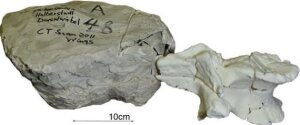by
Carol Ko, Staff Writer | November 20, 2013

Researchers in Berlin
recreated hidden,
unidentified dinosaur fossil
Ever dream of holding a sauropod skull in your hand? New imaging and printing technology may soon give the public unprecedented access to millions of fragile, rare fossils.
3-D printing has already received plenty of press for making anything from guns to bionic ears to guitars. But it also has broad applications for paleontologists, geologists and other researchers who handle rare artifacts.
Recently, a team of German researchers were able to virtually "unearth" and print a replica of a fossil without having to remove its protective plaster covering thanks to CT/3-D printing technology.



Ad Statistics
Times Displayed: 3028
Times Visited: 33 Fast-moving cardiac structures have a big impact on imaging. Fujifilm’s SCENARIA View premium performance CT brings solutions to address motion in Coronary CTA while delivering unique dose saving and workflow increasing benefits.
The technique could potentially be used to study and replicate fossils that are too fragile to be handled, the team reported in this week's issue of the journal Radiology.
The fossil was originally part of a collection that was buried under rubble in the Museum für Naturkunde in Berlin during a World War II bombing raid.
Because they were encased in protective plaster and some of the labels were destroyed during the bombing, museum staff still have trouble identifying and sorting some of the artifacts.
The study came about when museum paleontologist Dr. Oliver Wings approached Dr. Ahi Sema Issever, head of CT scanning at Charité Campus Mitte, to scan the specimen. Since bone and plaster absorb radiation at different rates, the CT scan is able to distinguish between them, enabling researchers to recreate the fossilized body.
Armed with the scan, researchers were able to solve a longstanding mystery about the origins of the fossil: though the fossil was originally thought to be taken from from African excavations in the early 1900s, researchers found that the fossil actually matched up with a sketch of a bone excavated from a clay pit south of Halberstadt, Germany, sometime between 1910 and 1927.
The 3D printing was almost an afterthought. "We wanted to see if we could do it," said Issever. While 3-D printers have been used to recreate fossils before, this was the first time a fossil was recreated from a specimen still encased in sediment.
The data from the CT scan was entered into the printer, resulting in a fossil replica that would have been impossible to create without risk of damaging the fossil itself.
"We were able to dissect the bone from the sediment without even manually doing it," said Issever.
Rock and roll
The technology could also revolutionize research and teaching for geologists, according to Franek Hasiuk, a geologist at Iowa State University.

